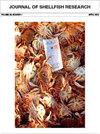热带河口珍珠牡蛎Pteria sterna(Gould,1851)中的MabéPearls
IF 1
4区 农林科学
Q3 FISHERIES
引用次数: 0
摘要
摘要对产于厄瓜多尔Chone河河口的Pteria sterna珍珠牡蛎中的mabé珍珠进行了质量评价。将成年牡蛎(总长70–75 mm)与半珍珠核嫁接,然后在灯笼网中以20个生物体/水平的密度保持在悬浮培养条件下。结果表明,培养条件对有核生物的发育产生了很大的负面影响,导致死亡率高,珍珠产量少。尽管死亡率很高,但成功存活了第二个月(22%)的牡蛎产下的珍珠层厚度沉积在植入细胞核顶部接近0.70毫米的珍珠,根据经典的分类标准(大小、光泽、杂质、圆度),大多数(>25%)为中等质量(A和B),其次是非商业珍珠(10%-27%)和15%的高AA质量mabé珍珠。一小部分被认为是宝石(<5%)。mabépearl的生产结构类似于在海洋环境中培养的P.sterna。结果表明,在Chone河河口,马贝珍珠可以在2个月内生产出来;然而,由于死亡率高,产量可能较低。建议进行进一步研究,以最大限度地降低死亡率,并建立更大的生产可行性。本文章由计算机程序翻译,如有差异,请以英文原文为准。
Mabé Pearls from the Pearl Oyster Pteria sterna (Gould, 1851) in a Tropical Estuary
ABSTRACT The quality of mabé pearls from pearl oysters, Pteria sterna, produced in the Chone River Estuary, Ecuador, was evaluated. Adult oysters (70–75 mm total length) were grafted with half-pearl nuclei and then maintained in suspended culture conditions in lantern nets at a density of 20 organisms/level. Results showed that the culture conditions generated a great negative influence on the development of nucleated organisms, which resulted in high mortalities and little pearl production. Despite the high mortality, the oysters that managed to survive the second month (22%), produced mabé pearls with nacre thickness deposited on the top of the implanted nucleus close to 0.70 mm, the majority (>25%) being of intermediate quality (A and B), according to classic classification criteria (size, luster, impurities, roundness), followed by noncommercial pearls (10%–27%) and 15% high-AA quality mabé pearls. A small fraction was considered as gems (<5%). The mabé pearl production structure is like that produced in P. sterna cultivated in marine environments. The results show that in the Estuary of the Chone River, mabé pearls can be produced in 2 mo; however, production can be low due to high mortalities. It is recommended to carry out further research to minimize mortality and establish greater production feasibility.
求助全文
通过发布文献求助,成功后即可免费获取论文全文。
去求助
来源期刊

Journal of Shellfish Research
生物-海洋与淡水生物学
CiteScore
2.30
自引率
0.00%
发文量
40
审稿时长
6 months
期刊介绍:
Original articles dealing with all aspects of shellfish research will be considered for publication. Manuscripts will be judged by the editors or other competent reviewers, or both, on the basis of originality, content, merit, clarity of presentation, and interpretations.
 求助内容:
求助内容: 应助结果提醒方式:
应助结果提醒方式:


